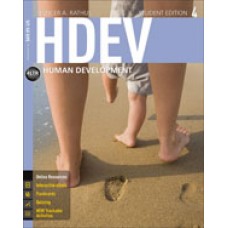Test Bank for HDEV, 4th Edition
$35.00 Original price was: $35.00.$26.50Current price is: $26.50.
Test Bank for HDEV, 4th Edition
Instant download Test Bank for HDEV, 4th Edition pdf docx epub after payment.

Product details:
- ISBN-10 : 1305257588
- ISBN-13 : 978-1305257580
- Author: Spencer A. Rathus
Created by the continuous feedback of a “student-tested, faculty-approved” process, HDEV4 traces development from infancy through late adulthood through a visually-appealing print component complete with tear-out review cards for students and class prep cards for instructors. Additionally, HDEV4 includes an online study center offering with CourseMate that includes an eBook and set of interactive digital tools to address multiple-learning styles, all at a value-based price. HDEV4 was developed with considerable input from focus groups, surveys, and conversations with students and instructors resulting in high-interest and comprehensive content, current examples, and a personal tone that accommodates sociology students’ lifestyles and is proven to increase retention and enhance outcomes.
Table of contents:
- Part 1
- Ch 1: History, Theories, and Methods
- 1-1 The Development of the Study of Development
- 1-2 Theories of Development
- 1-3 Controversies in Development
- 1-4 How Do We Study Development?
- Ch 2: Heredity and Prenatal Development
- 2-1 The Influence of Heredity on Development
- 2-2 Heredity and the Environment
- 2-3 Conception: Against All Odds
- 2-4 Prenatal Development
- Part 2
- Ch 3: Birth and the Newborn Baby: In the New World
- 3-1 The Stages of Childbirth
- 3-2 Methods of Childbirth
- 3-3 Birth Problems
- 3-4 The Postpartum Period
- 3-5 Characteristics of Neonates
- Ch 4: Infancy: Physical Development
- 4-1 Physical Growth and Development
- 4-2 Development of the Brain and Nervous System
- 4-3 Motor Development
- 4-4 Sensory and Perceptual Development
- Ch 5: Infancy: Cognitive Development
- 5-1 Cognitive Development: Jean Piaget
- 5-2 Information Processing
- 5-3 Individual Differences in Intelligence among Infants
- 5-4 Language Development
- Ch 6: Infancy: Social and Emotional Development
- 6-1 Attachment: Bonds That Endure
- 6-2 When Attachment Fails
- 6-3 Day Care
- 6-4 Emotional Development
- 6-5 Personality Development
- Part 3
- Ch 7: Early Childhood: Physical and Cognitive Development
- 7-1 Growth Patterns
- 7-2 Motor Development
- 7-3 Health and Illness
- 7-4 Sleep
- 7-5 Elimination Disorders
- 7-6 Jean Piaget’s Preoperational Stage
- 7-7 Factors in Cognitive Development
- 7-8 Theory of Mind
- 7-9 Development of Memory
- 7-10 Language Development: Why “Daddy Goed Away”
- Ch 8: Early Childhood: Social and Emotional Development
- 8-1 Dimensions of Child Rearing
- 8-2 Social Behaviors
- 8-3 Personality and Emotional Development
- 8-4 Development of Gender Roles and Gender Differences
- Ch 9: Middle Childhood: Physical and Cognitive Development
- 9-1 Growth Patterns
- 9-2 Motor Development
- 9-3 Children with Disabilities
- 9-4 Cognitive Development
- 9-5 Moral Development: The Child as Judge
- 9-6 Information Processing: Learning, Remembering, Problem Solving
- 9-7 Intellectual Development, Creativity, and Achievement
- 9-8 Language Development and Literacy
- Ch 10: Middle Childhood: Social and Emotional Development
- 10-1 Theories of Social and Emotional Development in Middle Childhood
- 10-2 The Family
- 10-3 Peer Relationships
- 10-4 The School
- 10-5 Social and Emotional Problems
- Part 4
- Ch 11: Adolescence: Physical and Cognitive Development
- 11-1 Puberty: The Biological Eruption
- 11-2 Health in Adolescence
- 11-3 Cognitive Development: Piaget’s Stage of Formal Operations
- 11-4 Gender Differences in Cognitive Abilities
- 11-5 Moral Development
- 11-6 The Adolescent in School
- 11-7 Adolescents in the Workforce
- Ch 12: Adolescence: Social and Emotional Development
- 12-1 Development of Identity: “Who Am I?”
- 12-2 Relationships with Parents and Peers
- 12-3 Sexuality
- 12-4 Juvenile Delinquency
- 12-5 Suicide: When the Adolescent Has Nothing-Except Everything-To Lose
- Ch 13: Early Adulthood: Physical and Cognitive Development
- 13-1 Emerging Adulthood
- 13-2 Physical Development
- 13-3 Health and Fitness
- 13-4 Sexuality
- 13-5 Cognitive Development
- 13-6 Career Development
- Ch 14: Early Adulthood: Social and Emotional Development
- 14-1 Separation
- 14-2 Intimacy versus Isolation
- 14-3 Seasons of Life
- 14-4 Attraction and Love: Forces That Bind?
- 14-5 Loneliness
- 14-6 The Single Life
- 14-7 Cohabitation: Darling, Would You Be My POSSLQ?
- 14-8 Marriage: Tying the Knot
- 14-9 Parenthood
- 14-10 Divorce: Breaking Bonds
- Part 5
- Ch 15: Middle Adulthood: Physical and Cognitive Development
- 15-1 Physical Development
- 15-2 Health
- 15-3 The Immune System
- 15-4 Sexuality
- 15-5 Cognitive Development
- 15-6 Creativity and Learning
- Ch 16: Middle Adulthood: Social and Emotional Development
- 16-1 Theories of Development in Middle Adulthood
- 16-2 Stability and Change in Middle Adulthood
- 16-3 Work in Middle Adulthood
- 16-4 Relationships in Middle Adulthood
- Ch 17: Late Adulthood: Physical and Cognitive Development
- 17-1 Physical Development
- 17-2 Theories of Aging
- 17-3 Health Concerns and Aging
- 17-4 Cognitive Development
- Ch 18: Late Adulthood: Social and Emotional Development
- 18-1 Theories of Social and Emotional Development in Late Adulthood
- 18-2 Psychological Development
- 18-3 Social Contexts of Aging
- 18-4 Retirement
- 18-5 Successful Aging
- Ch 19: Life’s Final Chapter
- 19-1 Understanding Death and Dying
- 19-2 Where People Die
- 19-3 Euthanasia: Is There a Right to Die?
- 19-4 Life-Span Perspectives on Death
- 19-5 Coping with Death
- Answers to Study Tools Questions
- References
- Name Index
- Subject Index
- Chapter Review
People also search:
HDEV, 4th Edition
HDEV, 4th Edition pdf
HDEV
human development and family studies
human development and family studies jobs
human development approach
human development and family science
Related products
Test Bank
Test Bank for Decision Support and Business Intelligence Systems, 9th Edition: Efraim Turban











